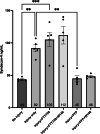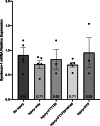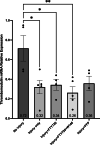Fingolimod does not prevent syndecan-4 shedding from the endothelial glycocalyx in a cultured human umbilical vein endothelial cell model of vascular injury
- PMID: 35980492
- PMCID: PMC9388705
- DOI: 10.1186/s40635-022-00462-7
Fingolimod does not prevent syndecan-4 shedding from the endothelial glycocalyx in a cultured human umbilical vein endothelial cell model of vascular injury
Abstract
Background: Shedding of the endothelial glycocalyx (EG) is associated with poor outcomes in a range of conditions including sepsis. Fresh frozen plasma (FFP) restores the damaged EG to baseline thickness, however the mechanism for this effect is unknown, and some components of FFP have adverse effects unrelated to the EG. There is some limited evidence that sphingosine-1-phosphate (S1P) within FFP restores the EG by activating the endothelial cell S1P receptor 1 (S1PR1). However, there are disadvantages to using S1P clinically as an EG restorative therapy. A potential alternative is the S1PR agonist fingolimod (FTY720). The aim of this study was to assess whether FTY720 prevents EG shedding in injured cultured human umbilical vein endothelial cells.
Methods: Shedding of the EG was induced in cultured human umbilical vein endothelial cells (HUVECs) by exposure to adrenaline, TNF-α and H2O2. The cells were then assigned to one of six conditions for 4 h: uninjured and untreated, injured and untreated, injured and treated with FTY720 with and without the S1PR1 inhibitor W146, and injured and treated with 25% FFP with and without W146. Syndecan-4, a component of the EG, was measured in cell supernatants, and syndecan-4 and thrombomodulin mRNA expression was quantitated in cell lysates.
Results: The injury resulted in a 2.1-fold increase in syndecan-4 (p < 0.001), consistent with EG shedding. Syndecan-4 and thrombomodulin mRNA expression was increased (p < 0.001) and decreased (p < 0.05), respectively, by the injury. Syndecan-4 shedding was not affected by treatment with FTY720, whereas FFP attenuated syndecan-4 shedding back to baseline levels in the injured cells and this was unaffected by W146. Neither treatment affected syndecan-4 or thrombomodulin mRNA expression.
Conclusions: FTY720 did not prevent syndecan-4 shedding from the EG in the HUVEC model of endothelial injury, suggesting that activation of S1PR does not prevent EG damage. FFP prevented syndecan-4 shedding from the EG via a mechanism that was independent of S1PR1 and upregulation of SDC-4 production. Further studies to examine whether FTY720 or another S1PR agonist might have EG-protective effects under different conditions are warranted, as are investigations seeking the mechanism of EG protection conferred by FFP in this experimental model.
Keywords: Cell culture; Endothelium; FTY720; Fingolimod; Fresh frozen plasma; Glycocalyx; Human umbilical vein endothelial cells; Sphingosine 1-phosphate; Syndecan-1; Syndecan-4.
© 2022. The Author(s).
Conflict of interest statement
The authors declare that they have no competing interests.
Figures






Similar articles
-
Sphingosine-1-phosphate improves endothelialization with reduction of thrombosis in recellularized human umbilical vein graft by inhibiting syndecan-1 shedding in vitro.Acta Biomater. 2017 Mar 15;51:341-350. doi: 10.1016/j.actbio.2017.01.050. Epub 2017 Jan 18. Acta Biomater. 2017. PMID: 28110073
-
Fresh frozen plasma lessens pulmonary endothelial inflammation and hyperpermeability after hemorrhagic shock and is associated with loss of syndecan 1.Shock. 2013 Sep;40(3):195-202. doi: 10.1097/SHK.0b013e31829f91fc. Shock. 2013. PMID: 23807246 Free PMC article.
-
Protective effects of plasma products on the endothelial-glycocalyx barrier following trauma-hemorrhagic shock: Is sphingosine-1 phosphate responsible?J Trauma Acute Care Surg. 2019 Nov;87(5):1061-1069. doi: 10.1097/TA.0000000000002446. J Trauma Acute Care Surg. 2019. PMID: 31453986
-
Endothelial Glycocalyx as a Shield Against Diabetic Vascular Complications: Involvement of Hyaluronan and Hyaluronidases.Arterioscler Thromb Vasc Biol. 2018 Jul;38(7):1427-1439. doi: 10.1161/ATVBAHA.118.310839. Epub 2018 Jun 7. Arterioscler Thromb Vasc Biol. 2018. PMID: 29880486 Free PMC article. Review.
-
Resuscitating the Endothelial Glycocalyx in Trauma and Hemorrhagic Shock.Ann Surg Open. 2023 Jun 28;4(3):e298. doi: 10.1097/AS9.0000000000000298. eCollection 2023 Sep. Ann Surg Open. 2023. PMID: 37746602 Free PMC article. Review.
Cited by
-
Shed Syndecan-4 and Its Possible Roles in Osteoarthritis.Biomedicines. 2025 Apr 25;13(5):1037. doi: 10.3390/biomedicines13051037. Biomedicines. 2025. PMID: 40426865 Free PMC article. Review.
-
Hydroxysafflor yellow A, a natural food pigment, ameliorates atherosclerosis in ApoE-/- mice by inhibiting the SphK1/S1P/S1PR3 pathway.Food Sci Nutr. 2024 Sep 14;12(11):8939-8955. doi: 10.1002/fsn3.4466. eCollection 2024 Nov. Food Sci Nutr. 2024. PMID: 39620014 Free PMC article.
References
LinkOut - more resources
Full Text Sources

